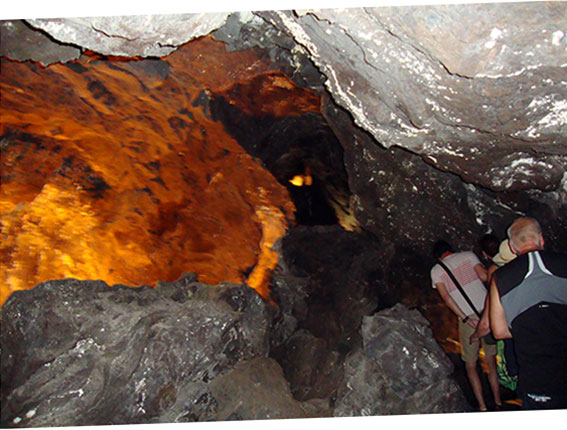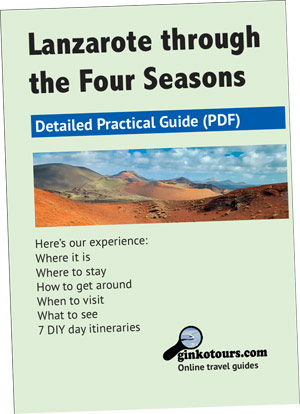The architect and artist Manrique and the volcanic caves
Visit of César Manrique House Museum

In Haria we find the House-Museum of César Manrique. César Manrique was a famous painter, sculptor and architect. He was also a town-planner and environmentalist.
He gave new shape to many sites of Lanzarote, in creating architectural works in harmony with the volcanic nature of the island.
Visiting the house will give you a better understanding of his artistic skills and his ideas about ecology in respecting the environment. Each room is different and characterized by a particular color, the large glass windows and bathroom overlook the garden.
The panorama from Mirador de Guinate

Mirador de Guinate is a viewpoint overlooking the island of la Graciosa and Mirador del Rio. You can access Mirador de Guinate from the village of Guinate, there is a deviation which leads to the viewpoint.
From the small terrace the gaze gets lost far away; even though the view is not as spectacular as the one of Mirador del Rio (paid admission), here the experience can be enjoyed better as it’s not overly-crowded.
The cave of Cueva de los Verdes

Part of the creative works of César Manrique, Cueva de los Verdes is a natural attraction of Lanzarote which should not be missed. This extraordinary lava cave formed in volcanic rock won’t leave anyone indifferent. The section opened to visitors is 1 Kilometer in length with some points not higher than 120 centimeters. At the end of the tour a beautiful and unexpected surprise will leave you spellbound.
The Artist Cave – Jameos del Agua

Jameos del Agua is one of Lanzarote’s most extraordinary attractions, often referred to as the island’s artist cave — a place where creativity, architecture, and the forces of nature blend in perfect harmony. This remarkable site is part of the visionary environmental projects of César Manrique, the celebrated Canarian creator who devoted his life to preserving and enhancing the island’s natural beauty.
Formed within a volcanic tunnel, Jameos del Agua is a stunning example of how nature’s raw elements can be transformed into a space of culture and inspiration. Manrique saw the potential hidden inside the lava formations and used his artistic vision to integrate architecture seamlessly into the landscape. What was once a rugged volcanic cavity is now a masterpiece of design — a sanctuary that celebrates the dialogue between humankind and the Earth.
Inside the artist cave, visitors are greeted by a serene atmosphere where the play of light, stone, and water creates a surreal and peaceful environment. The central feature is a crystal-clear lagoon, whose still surface reflects the dark walls of the cave and the glimmers of natural light filtering through the openings above. This underground lake is home to a rare species of tiny white crabs, unique to this habitat and considered a natural symbol of Lanzarote.
One of the most remarkable aspects of Jameos del Agua is its acoustic perfection. Thanks to the shape of the volcanic chamber, the artist cave has become an exceptional venue for concerts and cultural performances. The sound resonates with astonishing clarity, turning each event into an almost spiritual experience. Music, in this setting, seems to merge with the echoes of the Earth itself.
The life of Cesar Manrique
Cesar Manrique, born in 1919 and passing away in 1992, represents a multifaceted figure: an artist, architect, sculptor, and fervent environmentalist from Arrecife, on the enchanting island of Lanzarote in the Canary Islands. His life and artistic production are intricately woven with his native land, contributing significantly to the cultural and artistic development of the Canary Islands.

Manrique’s educational journey saw him study architecture at the University of La Laguna in Tenerife, later moving to Madrid in 1945 to deepen his knowledge at the Academy of Fine Arts of San Fernando. His European experiences and the time spent in New York after his studies marked an important phase of experimentation, during which he shaped his artistic identity.
Celebrated for his unique style, Manrique fused surrealistic, abstract, and cubist elements in his works, spanning from painting to sculpture, graphics, and architecture. His creations reflect a deep connection with nature and the surrounding environment.
Particularly relevant is his vision of integrated architecture with the natural environment. Upon his return to Lanzarote in the 1960s, he played a key role in promoting an architectural approach that harmonizes with the volcanic landscape of the island. Manrique directed the design of numerous architecturally significant works in Lanzarote, including his residence called “Taro de Tahiche.”
Manrique was not only a creator but also a passionate advocate for the environment. In 1982, he contributed to the foundation of the Fundación Cesar Manrique, a non-profit organization dedicated to promoting sustainable development and environmental conservation through art and architecture. The foundation manages some of the main tourist attractions in Lanzarote, including Jameos del Agua and Mirador del Río.
His death in 1992, in a tragic road accident in Lanzarote, prematurely ended his physical presence, but his impact persists. Manrique’s work continues to inspire artists and nature enthusiasts, while the Fundación Cesar Manrique persists in its commitment to preserving and transmitting the legacy of this extraordinary artistic polymath.
You’ll find many additional tips and recommendations in the online guide, which is also available as a downloadable PDF below.


